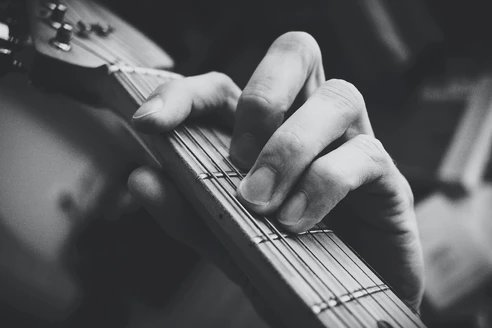If your guitar hasn’t been playing well, it’s likely that your frets aren’t in the best of conditions. If it’s dented, pitted, or looks flat, it’s time for your guitar to undergo some extensive fretwork. The fretwork required can be explained as follows:
Level
Fret level (or fret dress) is the process of abrading the fret tops to ensure that each fret on the neck of the guitar is on the same plane – i.e., removing excess metal from the tops of high frets in an attempt to level them with their neighbors. Additionally, leveling can be performed to correct divots left by strings on older frets and by bringing unworn frets to the same height as worn ones to even out their lengths.
Crown
Leveling leaves the fret with a flattened top that causes the takeoff point of the strings to move closer to the bridge and screws with an intonation that feels less smooth. For this reason, you’re expected to recrown the frets after leveling. Crowning is a process that requires the filing of the metal shoulders on each set using adequate tools to reestablish the rounded crown for providing a positive takeoff point for the string situated in the exact center of the fret.
Refret
But what do you do if the fret wear is so deep that fret leveling causes the frets to stoop down too low, causing uncomfortable playing? This is where refret comes in. The lowest noted limit for the height of the crown has been noted as 0.025″, which is approximately 0.65 millimeters. If you’re lying lower, you’re in for a treat at the refret territory.

To refret a guitar is to remove its existing worn-out frets from the neck of the guitar, install new ones, and level them. Remember, a botched refret will only cost you more, so you must address all concerns adequately. Your guitar may call for a partial refret if your concern is a high fret caused due to being pushed inward, improperly sealed fret, or shrinkage of the fretboard. However, suppose you experience frequent discomfort due to the thickness of the fret wire or the fretboard’s radius or encounter a rising tongue in a guitar with bolt-in necks. In that case, the only solution is a complete refret.
Sometimes after a refret, you may notice that the nuts have gone far too low compared to the newer fret, which is why you must either replace or shim the nuts.
Welcome to Rock Guitars International, where Eddie A, the guitar luthier from California, manufactures high-performance guitars with custom designs. Each of Eddie’s guitars has been handcrafted and undergoes an extensive eight-step process for quality fretwork like no other. Buy custom Rock Guitars online from our inventory!


